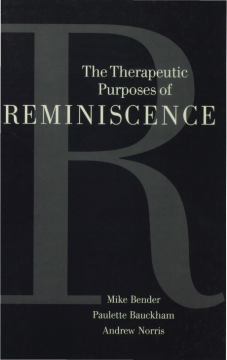
BOOK
The Therapeutic Purposes of Reminiscence
Mike Bender | Paulette Bauckham | Andrew Norris
(1998)
Additional Information
Book Details
Abstract
`I was impressed with the accessibility of the book, offering a guided tour through the history, context and purposes of reminiscence therapy, the range of applications from promoting social and emotional stimulation to reminiscence as psychotherapy. It also provides a brief overview of its theoretical underpinnings... As a book for health professionals interested in reminiscence work, it is a must for the shelf... most importantly it emphasizes the need for adequate training and supervision for those undertaking this type of work... the authors [also] provide a very good working guide to the assessment process' - Aging and Health
In this practical and accessible book, leading exponents of reminiscence work describe the purposes and techniques of reminiscence and set out detailed guidelines on how to implement and conduct a wide range of reminiscence activities with different types of client.
Highlighting its tremendous diversity and potential - and its special ability to allow people of all ages and abilities to communicate deeply about their lives - the authors separate out the different aims of reminiscence, which include intellectual or social stimulation, allowing people to leave behind them a cultural legacy, or a means of intergenerational communication. They show clearly how each can be directly beneficial either to clients or their carers, or for improving the culture of the arena in which the activity is being carried out.
`I was impressed with the accessibility of the book, offering a guided tour through the history, context and purposes of reminiscence therapy, the range of applications from promoting social and emotional stimulation to reminiscence as psychotherapy. It also provides a brief overview of its theoretical underpinnings and a philosophical view of reminiscence as enhancing unit cohesiveness. As a book for health professionals interested in reminiscence work, it is a must for the shelf. It provides a good basis from which to explore other topics and most importantly it emphasizes the need for adequate training and supervision for those undertaking this type of work. I was glad to see importance also given to assessment and the authors provide a very good working guide to the assessment process' - Aging and Health
`The text is user-friendly and features many tables and figures which illustrate or summarize important points...this is a most informative and readable book. Although the authors state that reminiscence work should not be limited to elderly people, most of the examples presented concern older adults. Therefore, this publication should be of particular interest to clinicians and students working with elderly people' - British Journal of Occupational Therapy
